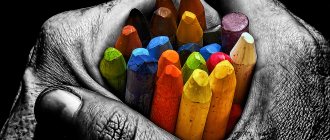Everything that surrounds us is a sign. Everything is a code
Visual communication should be considered as the process of transmitting information using visual language. This is a language of special symbols, logos, graphic and media elements. The cognitive basis of visual communication is its ability to engage and stimulate the activity of both hemispheres of the brain, allowing not only to convey target information in the most effective way, but also to ensure its assimilation.
As S. L. Rubinstein noted, in the process of phylogenesis, man was formed as an “optical being.” The role of visual images is very great, because 75% of the information we receive comes from vision, which gives us the most perfect, genuine perception of objects [6].
Something more
Obviously, visual perception means more than just what is described above. Vision is not passive perception. We get a world of images by looking at an object, analyzing it and studying it. The visual process means “grasping,” the rapid awareness of several characteristic features of an object: the rectangular shape of a book, the cold shine of metal, the straightness of a cigarette. Several lines and dots are easily perceived as a “face” [3]. It has been experimentally revealed that a person examines an object not along a random trajectory, but, as it were, sequentially touches with his gaze the most significant elements of the figure. Regular trajectories of inspection are formed only with the active interaction of visual and motor components.
The figure shows a recording of eye movements while freely viewing an image for two minutes.
Recordings of eye movements show that in the process of viewing, the observer's gaze usually lingers only on those elements that carry information that makes it possible to reveal the content of the image. Depending on the content of the object and the visual tasks that a person faces at the moment of perception, the distribution of fixation points on the object occurs, the sequence in which the gaze moves from one fixation point to another [2].
Constancy as one of the characteristics of visual perception
Definition 2
The category of constancy is understood as relative stability, independence of the image from the conditions of its perception. Constancy is reflected in the fact that the size, shape, color, and magnitude of a physical object are perceived as constant, despite the fact that the signals coming from the analyzed objects are constantly changing
The constancy of perception is ensured by the active actions of the perceptual system.
It is difficult to overestimate the importance of this quality of perception: in the absence of this property, with the slightest movement, changes in the distance to the object, with every turn of the head, changes in lighting, all the main signs of the object in the surrounding socio-natural environment, the surrounding reality itself, would constantly change, which would significantly complicate the process knowledge of objective reality would complicate the orientation of the individual in the surrounding world.
Do you need proofreading or review of academic work? Ask a question to the teacher and get an answer in 15 minutes! Ask a Question
Visual tasks
Visual tasks include:
- Detection, identification (recognition), identification. When detected, only the presence of the object is recorded
- Assigning it to a class of objects (according to the general characteristics of the class)
- Identification is a comparison of an object with a specific standard stored in memory.
There are also levels of perception:
- The first, lowest level of the hierarchical system of generalization of perception features consists of local features that characterize individual sections of the object’s contour, for example, convexity, kink, length.
- The next level of the hierarchy consists of generalized (secondary) features that characterize the entire object as a whole, for example: the number of angles, the number of concavities, the degree of ruggedness of the entire contour, etc.
- The third level consists of even more generalized – tertiary characteristics. They characterize not the contour of the perceived object itself, but its relationship with the contour of the auxiliary object, which is entirely formed mentally. Such features include the remoteness of the object, its compactness, and area.
- The highest level of the hierarchy is signs of similarity. They are denoted by the words: similar, reminiscent, close and contain information about not one, but about several objects in mutual relationships. They are stored in memory as information about the degree of qualitative and quantitative similarity of objects and reflect information not about the properties of the objects themselves, but only about the relationships between their properties.[1]
Ancient symbol
The perception of a sign developed in direct dependence on the laws of the psychology of visual perception. One of the earliest forms of visual communication is rock painting. Our predecessors were able to capture, with the help of conventional drawings, some details of their lives. They transmitted information, a special encoded message, the decoding of which did not require special knowledge; all knowledge was based only on the intuitive perception of the object [9].
Initially, there were two main figures: a point and a line. By combining them, it was possible to create only schematic images.
Gradually, the rock paintings became more complex, the number of drawn objects increased, and a plot appeared. New figures also appeared, namely: circle, triangle, square. This was the basic geometric set, which is still the basic one.
By transforming this basic set it was possible to obtain an oval, a diamond and a rectangle. By adding new geometric elements, more complex figures were obtained, three-dimensional forms appeared in the form of a ball, a pyramid and a parallelepiped. With the development of rock art, other forms of visual communication also developed: sculptures, drawings on fabric and household items. There was also a need for self-identification, to fully correspond to one’s social group. Now it was very important to introduce a special meaning into the sign, which only someone who was well acquainted with the specifics of the visual language and symbols of a particular people, a particular culture, could reveal. It happened that one symbol was interpreted differently in different cultures. This tendency most often appeared in various religious movements, and later in secret societies and schools.
The desire to be a member of the brotherhood, part of one’s culture, obliged one to be like one’s like-minded people and to actively use symbols related to their culture. And here the sign was perceived as an indicator: who this person is, what group he belongs to. This need for self-identification continues to this day. A person identifies himself with different communities and with the same activity uses the symbols of the cultural or religious area that he prefers.
Objectivity as an essential characteristic of visual perception
Definition 3
The category of objectivity is reflected in the fact that the object is perceived as isolated in space, a separate physical body.
The human brain divides the information from the surrounding reality coming from the perceptual system into two unequal parts: the background, which is perceived as an amorphous, unlimited, indefinite field, and the object - a clearly defined, concrete whole located in the foreground.
The clarity of highlighting an individual object is largely due to contrast. In the absence of pronounced contrast, the physical object merges with the background, which significantly complicates the processes of its cognition.
There are two types of contrast: direct, in which the object is darker than the background, and reverse, in which the object is perceived as brighter than the background.
Virtuosity
From a geometric set of shapes, various combinations and designs were created, the composition of which became much more complicated over time. Elements were added in order to more accurately convey the shape, structure, mood of the depicted object, and therefore the meaning, the encrypted code.
Gradually, the authors of visual communication symbols achieved virtuosity in its execution. Now the symbol has become not a simplified sign, but a special form of art. Here skill was primary. The popularity of both the element and the author-performer depended on how skillfully the author depicted this or that element.
The value orientation shifted towards the author's principle, and each of the masters wanted to succeed in their business more than others. Rivalry between creators arose, and cultural, religious groups and organizations needed not just special signs and special designations, but skillful depiction and execution of all the elements contained in them. But the sign as a type did not become more complicated. It remained the same, taking on a more artistic form
(Maximilian Lenz, "Peace" 1899)
All images are man-made. An image is a recreated vision. A phenomenon taken out of space and time where it first appeared and preserved for a few moments or for several centuries. Every image embodies a way of seeing. Even photography, contrary to popular belief, is not an automatic fixation. The perspective, angle, and subject of a photograph are always unique. And although every image embodies a certain way of seeing, our perception and evaluation, in turn, depend on our own way of seeing [4].
Every element of visual communication must express something. This means, first of all, that its content must be something more than a simple image of objects. Such a definition expands the concept of “expression” for any type of communication. For example, we usually say that a person “expresses his opinion.” However, the expressiveness of a sign is a more specific phenomenon. It requires that the connection of sense data give rise to “perception,” the active presence of forces that constitute the perceived pattern. But how is such perception achieved?
From the position of associative psychology, Theodor Lipps suggested that the perception of expressiveness implies the activity of forces. His theory of "feeling" was intended to explain why we find signs of expressiveness even in such inanimate objects as palace columns. The meaning of the theory was as follows: “When I look at the columns, based on my past experience, I know about the presence of mechanical compression and stretching in them. Also, from past experience, I know how I myself would feel if I were in the place of the column and if physical forces acted on my body from outside and inside it. I project my own kinesthetic sensations onto the column. In addition, the sensations of compression and stretching, which are taken from the “storehouse of memory,” tend to provoke a reaction in other areas of consciousness” [3].
Mechanism and types of perception
For the full development and effective learning of a child, a sufficient level of development of perception is necessary. It is the basis for the formation of other cognitive processes (memory, attention, thinking, speech and imagination). How does the process of perception occur?
- The world around us consists of various objects and phenomena that can be seen, heard, touched, tasted, smelled.
- With the help of our senses we learn about what an object is. For example, an orange has the following properties: round, orange, smooth, with small dimples on the peel, sour, and has a specific citrus smell.
- Information from the senses enters the brain, where individual sensations are combined into a holistic “picture” - perception.
- Perception is greatly influenced by accumulated life experience. If a child has already seen and eaten an orange, he does not need to taste it to guess what it is.
Classification of types of perception:
- Visual perception allows you to obtain a visual image of an object, as well as study its details;
- Auditory perception makes it possible to understand speech, recognize various sounds of nature, household noises and hear music;
- Tactile perception - cognition of objects through touch;
- Olfactory perception – recognition of odors;
- Taste perception – receiving information from taste buds (perception of sweet, salty, sour and bitter).
Most experts believe that each of us has a leading channel for receiving “data” about the world (usually vision, hearing or touch). Pay attention to the form in which your baby absorbs information better - this should be the main one in his learning.
Visual revolution
The socio-cultural environment of human activity since the beginning of the 21st century has been predominantly visually oriented. The modern idea of the world, where vision plays a decisive role, is based on visual images that determine the picture of reality. The visual forms themselves are used and presented in modern culture as corresponding to certain emotions, states, events, behavioral stereotypes, age and social characteristics of people.
From birth, a modern person is surrounded by a rich media environment that carries most of the information about the world; Thanks to the development of computer multimedia technologies and global information networks, also predominantly visually oriented, a unique opportunity has emerged, on the one hand, for communication with the entire cultural heritage of humanity, and on the other, for a targeted change in the content and structure of human consciousness.
It is the visual environment that creates the dominant tone of a person’s worldview; information flows carry a certain content, have a certain intensity and tempo-rhythmic characteristics. Visual communications in modern society are increasingly moving away from the role of a passive mediator, “overgrown” with codes and acquiring a pronounced manipulative character.
Russian designers: Ludwig Bystronovsky, Erken Kagarov, Egor Zhgun, Natalya Moskaleva, Mark Rodionov, Sergey Steblina
With the advent of modern technologies, special programs, and full-fledged graphic editors, human capabilities in creating elements of visual communication have expanded significantly. The need to convey information using symbols has increased greatly. Now we needed signs, emblems and symbols that would be understandable to everyone, and communication with which would be extremely simple. The modern system of symbols and notations is even simpler in design than the first rock paintings. Every year there is a clear tendency to simplify signs, use a minimum set of graphic elements, and free them from “extra” details.
Article Philosophy and psychology of the sign 17-18
- 17.jpg
- 18.png
Interestingly, along with the simplification of the elements in its details, its color scheme is also simplified. Saturated bright colors are gradually being abandoned in order to make visual communication between the recipient and the symbol as calm as possible, not irritating, and not causing additional emotions.
The influence of typography and aesthetics on the reading process
Did you know that typography can influence a person's mood and ability to make decisions?
Typography is the design and use of type as a means of visual communication. Nowadays, typography has moved from the field of book printing into the digital sphere. Summarizing all possible definitions of the term, we can say that the purpose of typography is to improve the visual perception of text.
In an experiment, Kevin Larson (Microsoft) and Rosalind Picard (MIT) found out how typography affects a reader's mood and problem-solving ability.
They conducted two studies, each involving 20 people. Participants were divided into two equal groups and given 20 minutes to read an issue of The New Yorker magazine on a tablet. One group received a text with bad typography, the other - with good typography (examples are given below):
During the experiment, participants were interrupted and asked how much time they thought had passed since the start of the experiment. According to psychological research (Weybrew, 1984), people who find their activities enjoyable and are in a positive mood report spending significantly less time reading.
After reading the texts, the experiment participants were asked to solve the candle problem. They had to attach the candle to the wall so that the wax would not drip, using pushpins.
How do we perceive good typography and its impact?
- Both groups of participants misestimated the time spent reading. This means that reading was a fun activity for them.
- Participants who were presented with text with good typography significantly underestimated their reading time compared to participants who were presented with text with poor typography. This means that they found the first text more interesting.
- None of the participants who read the text with poor typography were able to solve the candle problem. While less than half of the second group completed the task. Thus, good typography influenced the ability to solve problems.
Good typography influences the mood of users and their ability to make decisions
Tweet Quote
Tip: use readable fonts; separate text from images; do not overlay pictures or icons on the text; leave enough white space between paragraphs.
- Anatomy of a font: a visual guide to typography
Reaction to color
Color is primary in visual communication. A person’s visual perception is designed in such a way that when he sees a communicative object, he first of all pays attention to color. To see this clearly, take part in the “color test”:
Looking at these words, you need to say out loud the name of the color with which each of the words is written.
Your right hemisphere is trying to name the color, while your left hemisphere is trying to say the word.
This psychological test was proposed by the American John Ridley Stroop in 1935. It is based on the differences between visual and logical perception of color (it contrasts the real color and its name).
There is a widespread belief that the expressiveness of color is based on associations. It is said that the color red is stimulating because it reminds us of phenomena associated with fire, blood and revolution. The color green evokes in us the idea of the refreshing influence of nature, and, for example, the color blue evokes in us the feeling of touching cold water. People's reactions to different colors are presented in the table below (the table itself is also an example of visual communication).
Article Philosophy and psychology of the sign 20-22
- 20.jpg
- 21.jpg
- 22.jpg
How do elements of visual communication affect people?
A modern person has turned from a hunter for information into a collector of facts; he deliberately or unconsciously dwells on materials on a certain topic, expands his knowledge, finds hidden connections between various events, draws conclusions and predictions. That is, it uses media technology in which all modern types of media, formats and digital platforms are used to disclose the event. When using this technology, the material is transformed in such a way that the reader perceives the same event from a different angle each time, since media resources are logically connected to each other, while simultaneously remaining autonomous.
Visual barcode design.
Various interpretations of the simple sign are presented; the same element looks different thanks to non-standard solutions in its design
Article Philosophy and psychology of the sign 23-25
- 23.PNG
- 24.png
- 25.jpg
The creation and development of various visual communications is called “communication design”. The birth of this trend occurred after design “speaking.” He began to communicate with us using graphic concepts, and the key here is that we began to understand him. One of the most striking and successful examples of communicative design is the project of the Artemy Lebedev studio - the corporate identity for the Central Park named after. Gorky:
Article Philosophy and psychology of the sign 26-38
Artemy Lebedev studio - corporate identity for the Central Park named after. Gorky
- 26.gif
- 27.gif
- 28.jpg
- 29.gif
- 30.jpg
- 31.jpeg
- 32.jpg
- 33.jpg
- 34.jpg
- 35.jpg
- 36.jpg
- 38.jpg
- 37.jpg
Visual images are remembered faster and remain in human memory longer, which is associated with the associative nature of memory and the ability to distinguish objects by shape. Visualization develops analytical thinking and the ability to make your own conclusions [7]. For example, the perception of a web page occurs in the following order: visual blocks, images, title, text. At the same time, the title is first perceived as a visual image, a combination of size, color and graphic characters. Research shows that materials with the following ratios are the first to attract attention: visual content – 55–60%, headline – 10–15%, text – 30% [7].
Another trend, quite unpleasant. People don't want to read, but they want to know. Alexander Kupriyanov, HSE
Perceptual challenge
Man has created and continues to create an artificial habitat, projecting in external images the states of his inner world, both emotional and intellectual. Human consciousness uses decoding as a cultural basis of cognition [5]. However, the message is always primary; in its structure, every message is a text, and then an image. The text is transformed into an image, and the image is always textual. The world is visualized, where the text is filled with an image. Objectively, the text cannot exist without visual compensation, but the visual structure does not exist without textuality, otherwise it is simply meaningless.
The modern solution is a new textuality. This is, first of all, textuality of the second level, that is, a text that includes a visual structure (textuality of the first level is text in its pure form without distracting visual elements). It has become possible to combine image and text, where one is form, and the other is content [10]. In order not to lose the integrity of culture, it is necessary to use a second-level text, which is also valuable because it fits into modern technologies.
Modern communication design strives to become hyper-communicative, actively using the latest technologies. Attempts to overcome single-level text go back to the idea of “visual text”. Thus, text and visual image become one equivalent level, thereby moving into another, more complex system, where the medium is the content itself.
Article Philosophy and psychology of the sign 41-46
- 43.jpg
- 44.jpg
- 45.jpg
- 46.jpg
- 41.jpg
What is the key feature of modern visual culture?
A key feature of modern visual culture is the quantitative and qualitative growth of various visualization technologies, which constantly and everywhere give rise to new segments of visual culture, new visual environments [11].
The primary message will always be a set of meanings that make up the idea of the message. It is expressed by visual means with varying degrees of adequacy, but at the same time its distortion inevitably occurs [8]. Some details of the initial message are lost due to insufficient expressiveness of the visual means, and, conversely, the implementation of the message always introduces something new into it that was not originally intended to be sent.
Visualization makes it possible to present complex and difficult-to-understand material in a form that not only attracts attention and ensures its concentration on the subject of knowledge, but also arouses interest, which has a positive effect on the assimilation of information.
The culture of visual perception is very young. Today, special visual accents are required to attract attention. The material must now be, first of all, attractive in order to be remembered and fixed in the mind. This is a very important aspect in creating visual communications, because the design language has become understandable to many, it has become pleasant to talk to, and an abstract universal sign has appeared. Modern society “translates” the world for itself with the help of these signs that speak not only about their generation, but also with it. Communicating with visual elements, a person begins to trust them, because they are the ones who help him find the right metro station, gas station or workshop. They become his companions throughout his life.
Visual communications have gone from cave paintings to modern navigational signs, revealing to us a completely new visual way of communication that is firmly entrenched in modern society.
Empirical characteristics of visual perception
At its core, the process of perception has a dual nature: perception is maximally objective at the level of primary sensory processes; at the same time, perception is deeply subjective in the subsequent interpretation of the received information, when imagination and memory are included in the processing.
Finished works on a similar topic
Coursework Visual perception 440 ₽ Abstract Visual perception 230 ₽ Test paper Visual perception 240 ₽
Receive completed work or specialist advice on your educational project Find out the cost
In addition, perception has a number of unique characteristics, including the properties of constancy, objectivity, integrity and generality.









